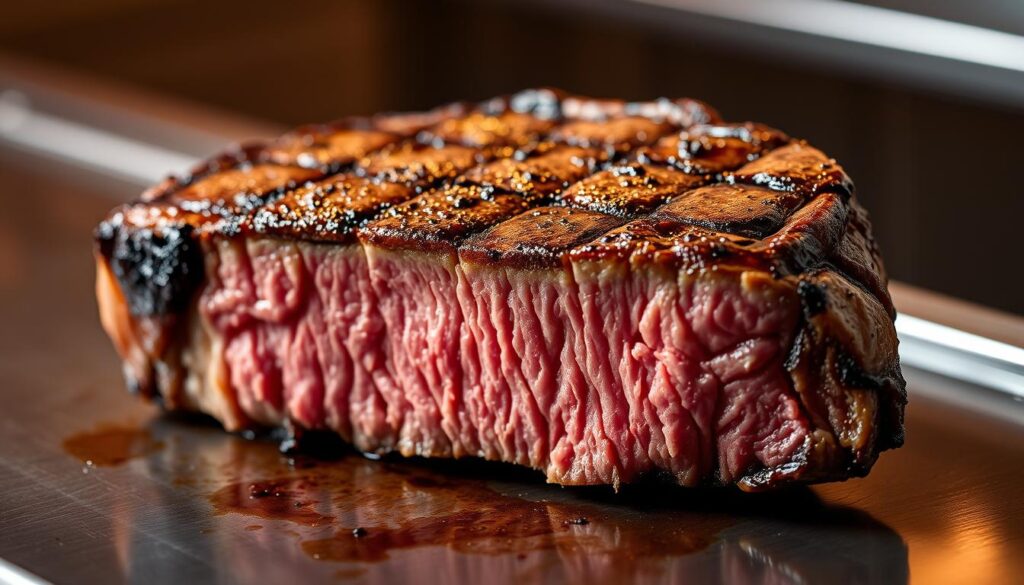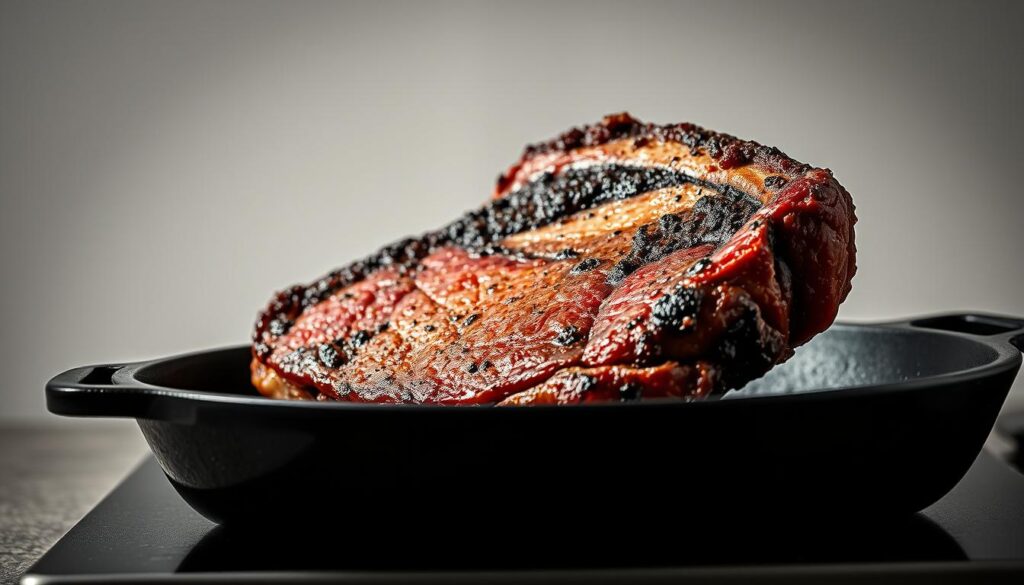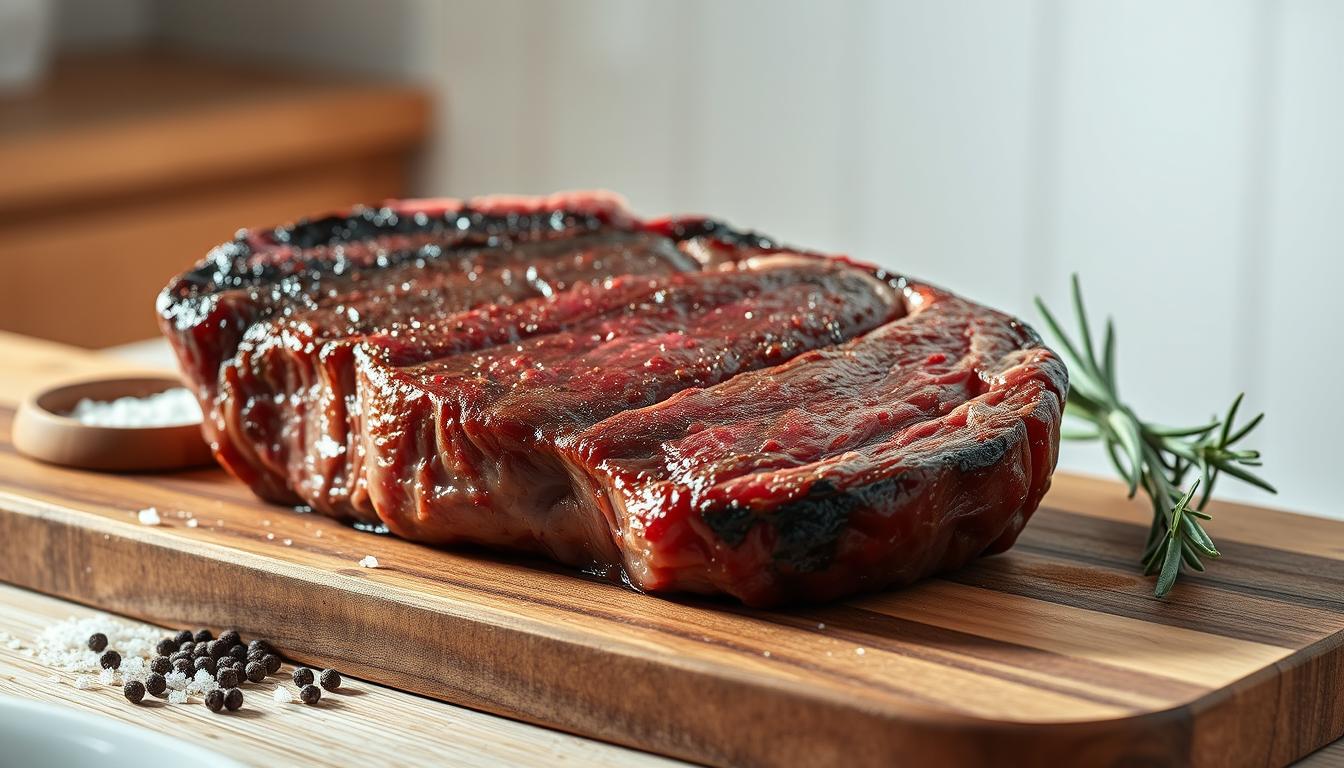How to Cook Bone-In Ribeye Like a Pro
The first time I sliced into a perfectly cooked bone-in ribeye, I knew something magical happened in my kitchen. Steak isn’t just food—it’s an experience that connects us to centuries of culinary tradition. Your journey to mastering the ultimate bone-in ribeye starts here, transforming an ordinary cut into a restaurant-quality masterpiece.
This prime rib roast descendant represents the pinnacle of beef excellence. From professional chefs to home cooking enthusiasts, the bone-in ribeye demands respect, technique, and a deep understanding of meat preparation. Whether you’re cooking for a special occasion or simply craving an exceptional meal, this guide will elevate your steak game.
Table of Contents
Understanding Bone-In Ribeye Cuts
Exploring premium beef cuts opens a world of tasty options. The ribeye family offers some of the most spectacular steaks. Each cut has unique features that meat lovers enjoy.
Ribeye steaks come in several distinctive cuts. These cuts can elevate your cooking skills. Let’s look at the most popular ones:
- Tomahawk Steak: A dramatic cut with an extended bone, like a Native American tomahawk axe
- Cowboy Ribeye: A robust cut with a shorter bone, great for those who love intense meat
- Standing Rib Roast: An elegant whole-muscle cut perfect for special occasions
USDA Grading Explained
Understanding USDA beef grades is key to choosing high-quality meat. The system looks at maturity and marbling. Prime, Choice, and Select grades show different quality levels, with Prime being the best.
Marbling: The Secret to Flavor
Marbling is the fat in meat that makes it taste rich and tender. The more marbling, the juicier and tastier your steak. When picking a tomahawk steak or cowboy ribeye, look for white fat streaks.
Knowing these differences makes you a better meat connoisseur. You can pick the perfect cut for any event.
Essential Equipment for Perfect Bone In Ribeye
Cooking a top-notch bone-in steak needs more than just skill. The right tools can make your beef rib section cooking go from good to great. Choosing the right equipment ensures you get that perfect sear and delicious taste every time.
To become a pro at cooking bone-in steak, you’ll need a few key tools:
- Cast Iron Skillet: The ultimate tool for creating a perfect crust
- Reliable Meat Thermometer: Critical for precise temperature control
- High-Quality Tongs: For safely handling and turning your steak
- Wire Rack: Essential for dry brining and resting
- Heavy-Duty Cutting Board: Provides stable surface for preparation
Your cast iron skillet is the most important tool. Its ability to hold heat well and distribute it evenly is perfect for a professional sear on your beef rib section. Many chefs swear by cast iron for its unmatched performance.
| Equipment | Purpose | Recommended Type |
|---|---|---|
| Cast Iron Skillet | Creating perfect sear | 12-inch pre-seasoned skillet |
| Meat Thermometer | Temperature monitoring | Digital instant-read |
| Tongs | Steak handling | 16-inch stainless steel |
Investing in quality tools will greatly enhance your bone-in steak cooking. Each tool has a specific role in helping you create a restaurant-quality meal at home.
The Science of Dry Brining
Preparing a usda prime ribeye is more than just picking a good cut. Dry brining is a technique that turns a regular steak into a restaurant-quality dish. It boosts the steak’s natural flavors and makes it incredibly tender.
Salt Ratio and Timing
Getting dry brining right is all about precision. For a usda prime ribeye, use about 1/2 teaspoon of kosher salt for every pound of meat. The timing is important – salt your steak between 2-8 hours before cooking. Thinner cuts need shorter times, while thicker ones benefit from longer brining.
- 1/2 teaspoon kosher salt per pound
- 2-8 hours brining time
- Pat steak dry before salting
Chemical Process and Benefits
Dry brining starts a cool scientific process. Salt pulls moisture to the steak’s surface. Then, as time goes by, the moisture goes back in, breaking down muscle proteins. This makes the steak tender, full of flavor, and juicy.
Proper Storage During Brining
Storing your steak right is key for safety and the best taste. Put your salted steak on a wire rack over a plate to catch drips. Keep it in the fridge, uncovered, to let air circulate and create a great crust when cooking. This method prevents moisture buildup and gives your usda prime ribeye a perfect texture.
- Use wire rack for air circulation
- Refrigerate uncovered
- Keep away from other foods
Temperature Management Secrets

Mastering temperature control is key to cooking the perfect dry aged ribeye. The steak’s starting temperature greatly affects its taste and texture. Knowing this can turn a simple meal into a culinary masterpiece.
Different doneness levels need specific temperature approaches:
- Rare to Medium-Rare: Start with cold steak directly from refrigerator
- Medium to Well-Done: Allow steak to reach room temperature before cooking
When cooking a dry aged ribeye, precision is important. Cold steaks cook more evenly, preventing overcooking on the outside. They also keep the inside tender. Room temperature steaks cook faster and more consistently.
Important temperature management techniques include:
- Use a reliable meat thermometer
- Monitor internal meat temperature carefully
- Remove steak slightly before desired doneness
- Let meat rest to complete cooking process
Professional chefs say to remove your dry aged ribeye from heat 5-10 degrees below target. This ensures a juicy and flavorful steak.
Seasoning and Preparation Techniques
Preparing a delicious bone in ribeye is more than just adding salt and pepper. The right seasoning can make your prime rib roast stand out. Learning how to season and prepare your steak will boost your cooking skills and wow meat lovers.
Before cooking, your bone in ribeye needs careful attention. The goal is to add flavors that enhance the meat’s natural taste without overpowering it.
Basic Seasoning Blend
A classic seasoning blend for prime rib roast is simple:
- Kosher salt (coarse grain)
- Fresh cracked black pepper
- Granulated garlic powder
The best mix is 2 parts salt, 1 part pepper, and a bit of garlic powder. Generously coat the entire surface of the bone in ribeye, making sure it’s evenly spread.
Advanced Flavor Combinations
If you want more complex flavors, try these advanced seasoning options:
- Herb-infused salt blends
- Smoked paprika
- Dried rosemary
- Crushed red pepper flakes
Pre-Cooking Preparation Steps
Before cooking, follow these key steps:
- Pat the bone in ribeye dry with paper towels
- Let the steak sit at room temperature for 30-45 minutes
- Apply seasoning just before cooking
- Make sure the meat surface is dry for the best crust
By using these seasoning and preparation techniques, you’ll make a prime rib roast that’s full of flavor, tender, and unforgettable.
Two-Step Cooking Method

Learning the two-step cooking method can make your tomahawk steak or standing rib roast amazing. It combines the perfect sear with even internal cooking.
Start by pan searing. Use a heavy cast-iron skillet that can handle high heat. Your aim is to get a tasty, caramelized crust that keeps the meat’s flavors in.
- Preheat your skillet until it’s smoking hot
- Sear each side of the tomahawk steak for 2-3 minutes
- Develop a rich, golden-brown exterior
Then, move your standing rib roast to a preheated oven. This step cooks the meat gently and evenly. It keeps the meat tender and moist.
| Cooking Stage | Temperature | Duration |
|---|---|---|
| Stovetop Sear | High (450-500°F) | 2-3 minutes per side |
| Oven Finish | 325-350°F | 10-15 minutes per pound |
Pro tip: Use a meat thermometer to check the internal temperature. This ensures your dish turns out just right every time.
Creating the Perfect Crust
A golden, crispy exterior makes a cowboy ribeye stand out. It turns a simple bone-in steak into a dish that excites your taste buds. The crust locks in the meat’s amazing flavor.
To make a great crust, you need precision and skill. Success comes down to three key things:
- Pan selection
- Heat management
- Precise timing
Pan Selection and Heat Control
A cast iron skillet is the best for a perfect crust. It keeps heat well and sears evenly. Make sure it’s very hot before adding the steak.
Searing Technique
Use oil like avocado or grapeseed to prevent sticking. Brush your steak with it. Then, put the steak in the skillet and let it sear without moving it.
Visual Indicators of a Perfect Crust
Look for these signs of a well-seared steak:
- Deep golden-brown color
- Crisp, textured surface
- Slight smoking around the edges
- Visible caramelization
Your aim is a crust that’s crackling and flavorful. It should keep the steak’s juicy inside in.
Mastering Internal Temperature
Getting the perfect internal temperature is key when cooking a USDA prime ribeye. Your meat thermometer is essential for a perfectly cooked steak from the beef rib section.
Different levels of doneness need precise temperature control. Here’s a guide to help you get the perfect temperature:
- Rare: 125°F – Cool red center
- Medium-Rare: 130°F – Warm red center (Most recommended)
- Medium: 135-140°F – Warm pink center
- Medium-Well: 145-150°F – Slight pink center
- Well Done: 155-160°F – No pink
Professional chefs say to cook your USDA prime ribeye to medium (135-140°F). This keeps its rich flavor and tender texture. It’s important to understand carryover cooking – your steak cooks a bit more after it’s removed from heat.
When using a meat thermometer, put it into the thickest part of the steak. Avoid fat or bone. For the best reading, take your ribeye off the heat 5 degrees before your target temperature. This accounts for the extra cooking.
Remember, patience and precision make a good steak into an amazing dining experience in your beef rib section culinary journey.
Resting and Serving Tips
Resting your marbled ribeye is key to a great steak. After cooking it perfectly, waiting patiently is the secret to the best flavor and tenderness.
Resting lets the meat’s juices spread out evenly. So, when you cut into it, the juices stay inside, keeping the meat juicy and tasty.
- Remove the steak from heat source immediately after cooking
- Place the steak on a warm plate or cutting board
- Tent loosely with aluminum foil
- Let the marbled ribeye rest for 5-7 minutes
Timing is important when resting your dry aged ribeye. Rest it for about 1 minute for every 100 grams of meat. Bigger cuts need a bit longer to get the juices right.
When you serve, cut the steak against the grain for tenderness. A sharp knife makes clean cuts that highlight the ribeye’s marbling.
Pair your steak with simple sides that don’t hide its flavor. Try roasted veggies, creamy mashed potatoes, or a light herb salad to enhance your meal.
Conclusion
Cooking the perfect bone-in ribeye is a journey that mixes science, technique, and passion. You’ve learned the key skills to turn a regular steak into a memorable meal. From picking the right meat to controlling the temperature, each step is vital for a top-notch ribeye at home.
The techniques you’ve learned are more than just cooking. They’re a detailed way to make a bone-in ribeye that’s full of flavor and texture. With practice, you’ll get better at making each steak even more delicious. Remember, paying attention to seasoning, brining, and cooking temperature can make a big difference.
Your kitchen is now ready with expert-level knowledge for cooking bone-in ribeye. Whether it’s for a special event or a simple dinner, these methods will give you great results. Enjoy the process, trust your instincts, and feel free to try new things. The key to great cooking is passion, practice, and a desire to learn.
Ultimately, cooking the perfect bone-in ribeye is about making special moments at the table. With patience and focus, you’ll become confident in making steaks that wow and please. Your journey to becoming a home cooking pro begins now.
FAQ
What is the difference between a tomahawk steak and a cowboy ribeye?
How do I choose a high-quality ribeye steak?
What is dry brining, and why is it important?
What is the best way to cook a bone-in ribeye?
How long should I let my ribeye rest after cooking?
What’s the difference between USDA Prime and other grades?
Can I cook a bone-in ribeye on a grill?
How do I know when my ribeye is cooked to the right temperature?
There are no reviews yet. Be the first one to write one.

